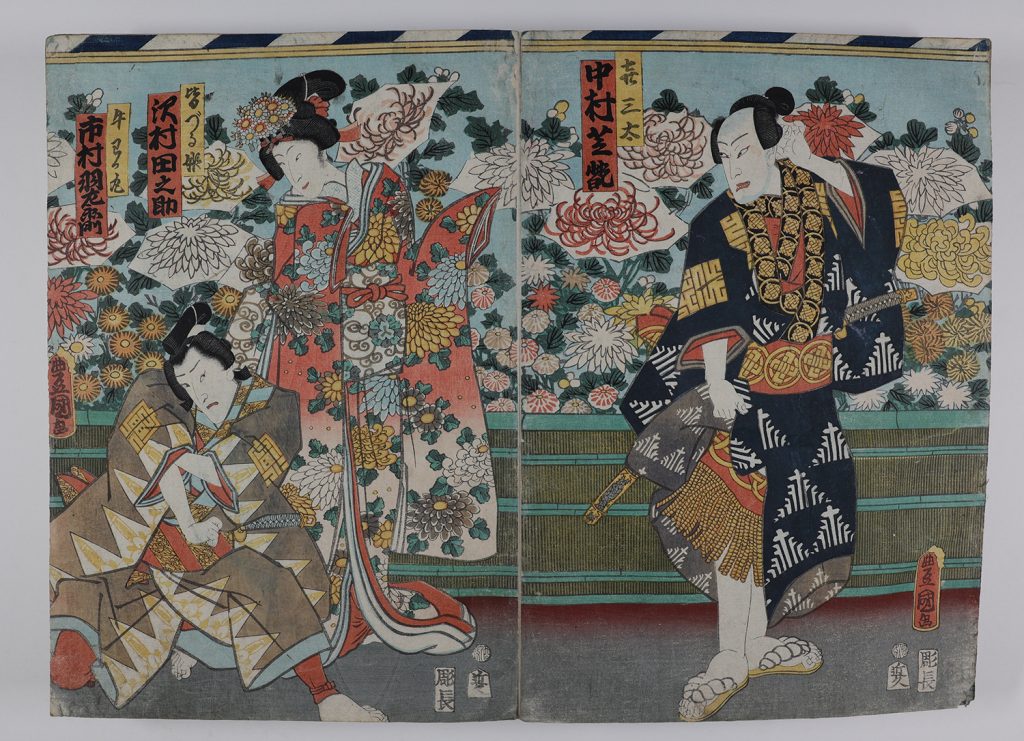Plates 06-07: Ichimura Uzaemon XIII, Sawamura Tanosuke III, and Nakamura Shikan IV in Kiichi Hōgen’s Book of Strategy
Plates 06-07: Ichimura Uzaemon XIII, Sawamura Tanosuke III, and Nakamura Shikan IV in Kiichi Hōgen’s Book of Strategy

Utagawa Kunisada 歌川国貞 (Utagawa Toyokuni III) (1786-1865)
Ichimura Uzaemon XIII, Sawamura Tanosuke III, and Nakamura Shikan IV in Kiichi Hōgen’s Book of Strategy (1861)
Ink and color on paper with mica in blue pigments
Seals:
Publisher: Omiya Kuhei
Censor: 1861-IX
Engraver: Horicho
Artist: “Kunisada ga” in a toshidama 年玉 cartouche
Utagawa Kunisada (1786-1865), born in Honjo of Edo, was an Edo-period (1603-1867) ukiyo-e artist whose influential career persisted through the ever-changing socio-political environment of the time. His career began around 1800 when he became an apprentice under Utagawa Toyokuni I 歌川豊国 (1769-1825). The Utagawa school was responsible for over half of the ukiyo-e prints during the nineteenth century and continued to portray different aspects of Edo until the Meiji Restoration (1868).1 This prominence of the Utagawa school allowed Kunisada and his colleagues the opportunity to translate culture and politics to art for wide audiences.2 His work was well received early on, prompting his success. As his style evolved, he began encompassing many types of prints including actors on and off stage (yakusha-e 役者絵), images for gōkan 合巻 (Japanese popular fiction writings), erotica (shunga 春画), beauties (bijin-ga 美人画), and images for Genji books.3 Kunisada was known for displaying a certain likeness of his subjects across the many genres of ukiyo-e in which he worked.4 A deep knowledge of kabuki plays and Edo-age brothels was also highly characteristic of Kunisada’s work. Since he had great experience in both environments, he became recognized for displaying the emotions of individuals in ways that other artists could not. Kitagawa Utamaro 喜多川歌麿 (1753-1806) was a significant predecessor and influences from Utamaro’s work can be seen throughout Kunisada’s career, especially in his bijin-ga.5 By the end of his career, Kunisada’s work was in such high demand that he required a highly organized studio which employed over 60 students and assistants.6
This specific work was published in 1861 by Ōmiya Kuhei. It features a bokashi 暈し (ombre) effect in the background. There is evidence that Kunisada used mica powder often during the first few decades of his career and was not able to use them again until the 1850s due to heavy regulation of materials in ukiyo-e.7 Kunisada’s signature here is typical of his later years as it is enclosed in a toshidama cartouche. The presence of an engraver’s seal on this print is slightly peculiar because often only the artist and publisher were given credit for work during this period, though it became more common shortly after.
The figures in the prints are Ichimura Uzaemon XIII 十三代目市村羽左衛門 (1844-1903) as Shimobe Torazō on the left, Sawamura Tanosuke III 三代目沢村田之助 (1845-1878) as Minazuru-hime in the center, and Nakamura Shikan IV 四代目中村芝翫 (1831-1899) as Shimobe Chienai on the right. The portrayed kabuki play Kiichi Hōgen’s Book of Strategy (Kiichi Hōgen sanryaku no maki 鬼一法眼三略巻), which is about three brothers loyal to the Genji clan in a society run by the Heike clan.8 In these specific prints, there is a juxtaposition between actors’ facial expressions and poses. While Ichimura Uzaemon XIII and Nakamura Shikan IV seem to be preparing for some sort of fight with stiffness and aggression, Sawamura Tanosuke III in the center is poised with a content look on his face. During the year of 1861, Kunisada portrayed these actors in many of his paintings, alluding to this diptych being (officially or not) part of a larger collection.
Samantha Oleson
Anthropology
Class of 2022
Annotated Bibliography
Izzard, Sebastian. “The bijin-ga of Utagawa Kunisada,” Impressions, no. 3, Japanese Art Society of America, 1979, pp. 1–5, http://www.jstor.org/stable/42598052.
Izzard’s article sheds light specifically on the bijin-ga works by Kunisada. The article discusses Utamaro’s influence on his bijin-ga, critics’ opinions on such works, and how they allowed scholars insight to the ideal female physique and clothing during the first half of the nineteenth century. Of note is the fact that this text is a bit dated, being published in 1979.
Mueller, Laura Jean. “Competition and Collaboration in Edo Print Culture: Lineage, Creative Specialization and Market Eminence for Artists of the Utagawa School, 1770 – 1900.” The University of Wisconsin – Madison, 2015. Ann Arbor: ProQuest. Web. 27 Feb. 2022.
Mueller’s dissertation covers the entire history of the Utagawa school with an emphasis on how the artists portrayed the sociopolitical environment throughout the Edo and beginning of the Meiji periods. Alongside the chronology of Utagawa artists, she discusses the growth and development of ukiyo-e, including such things as techniques and marketing. This paper helps to place Kunisada within the context of his school, therefore creating a better understanding of his lineage, influences, and progression.
Tinios, Ellis. “Greater than Utamaro: the Fame of Utagawa Kunisada.” Ukiyo-e art, vol. 171, International Ukiyo-e Society, 2016, pp. 95–113, https://doi.org/10.34542/ukiyoeart.1711.
This article gives a general summary of each type of art Kunisada did and its impact on the community and his reputation. It also compares him to his predecessor Kitagawa Utamaro and that Kunisada’s work surpasses his. It aids in creating a timeline of his career as well as information of his predecessors, colleagues, and pupils.
Tinios, Ellis. “Kunisada and the Last Flowering of ‘Ukiyo-e’ Prints.” Print Quarterly, vol. 8, no. 4, Print Quarterly Publications, 1991, pp. 342–62, http://www.jstor.org/stable/41824668.
This article focuses on the increased censorship of prints that began in the 1840s in the wake of economic famine. Its focus specifically on Kunisada’s beauties prints evolving to fit regulations adds a sociopolitical depth to understanding his work.
